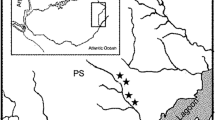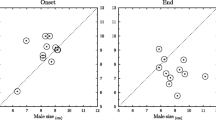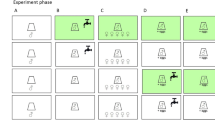Abstract
Sexual selection is potentially important in marine zooplankton, presumably the most abundant metazoans on earth, but it has never been documented. We examine the conditions for sexual selection through mate choice and describe mating preferences in relation to size in a marine zooplankter, the pelagic copepod Acartia tonsa. Males produce spermatophores at a rate (~1 day−1) much lower than known female encounter rates for most of the year and the decision to mate a particular female thus implies lost future opportunities. Female egg production increases with female size, and males mating larger females therefore sire more offspring per mating event. Similarly, females encounter males more frequently than they need to mate. Large males produce larger spermatophores than small males and the offspring production of female increases with the size of the spermatophore she receives. Additionally, large spermatophores allow females to fertilize eggs for a longer period. Thus, mating with large males reduces the female’s need for frequent matings and she may sire sons that produce more offspring because size is heritable in copepods. Finally, we show that both males and females mate preferentially with large partners. This is the first demonstration of sexual selection by mate choice in a planktonic organism.






Similar content being viewed by others
References
Ali AK, Primicerio R, Folstad I, Liljedal S, Berge J (2009) Morphological correlates of mating frequency and clutch size in wild caught female Eudiaptomus graciloides (Copepoda: Calanoida). J Plankton Res 31:389–397. doi:10.1093/plankt/fbn130
Andersson MB (1994) Sexual selection. Princeton University press, Princeton
Aquiloni L, Gherardi F (2008) Mutual mate choice in crayfish: large body size is selected by both sexes, virginity by males only. J Zool 274:171–179. doi:10.1111/j.1469-7998.2007.00370.x
Arendt KE, Jónasdóttir SH, Hasen PJ, Gartner S (2005) Effects of dietary fatty acids on the reproductive success of the calanoid copepod Temora longicornis. Mar Biol 146:513–530. doi:10.1007/s00227-004-1457-9
Bagøien E, Kiørboe T (2005) Blind dating-mate finding in planktonic copepods. III. Hydromechamical communication in Acartia tonsa. Mar Ecol Prog Ser 300:129–133. doi:10.3354/meps300129
Berggreen U, Hansen B, Kiørboe T (1988) Food size spectra, ingestion and growth of the copepod Acartia tonsa during development: implications for determination of copepod production. Mar Biol 99:341–352. doi:10.1007/BF02112126
Blades PI (1977) Mating behavior of Centropages typicus (Copepoda: Calanoida). Mar Biol 40:57–64. doi:10.1007/BF00390628
Boggs CL (1995) Male nuptial gifts: phenotypic consequences and evolutionary implications. In: Leather SR, Hardie J (eds) Insect reproduction. CRC, New York, pp 214–242
Choi KH, Kimmerer WJ (2008) Mate limitation in an estuarine population of copepods. Limnol Oceanogr 53:1656–1664
Choi KH, Kimmerer WJ (2009) Mating success and its consequences for population growth in an estuarine copepod. Mar Ecol Prog Ser 377:183–191. doi:10.3354/meps07819
Doall MH, Colin SP, Stricker JR, Yen J (1998) Locating a mate in 3D: the case of Temora longicornis. Phil Trans R Soc Lond B 353:681–689
Dutz J (1998) Repression of fecundity in the neritic copepod Acartia clausi exposed to the toxic dinoflagellate Alexandrium lusitanicum: relationship between feeding and egg production. Mar Ecol Prog Ser 175:97–107. doi:10.3354/meps175097
Gauld DT (1957) Copulation in calanoid copepods. Nature 180:510. doi:10.1038/180510a0
Heuch PA, Schram TA (1996) Male mate choice in a natural population of the parasitic copepod Lernaeocera branchialis (Copepoda: Pennellidae). Behaviour 133:221–239
Ianora A, Miralto A, Buttino I, Romano G, Poulet SA (1999) First evidence of some dinoflagellates reducing male copepod fertilization capacity. Limnol Oceanogr 44:147–153
Janetos AC (1980) Strategies of female mate choice: a theoretical analysis. Behav Ecol Soc 7:107–112
Jersabek CD, Luger MS, Schabetsberger R, Grill S, Stricker JR (2007) Hang on or run? Copepod mating versus predation risk in contrasting environments. Oecologia 153:761–773. doi:10.1007/s00442-007-0768-1
Katajisto T, Viitasalo M, Koski M (1998) Seasonal occurrence and hatching of calanoid eggs in sediments of the northern Baltic Sea. Mar Ecol Prog Ser 163:133–143. doi:10.3354/meps163133
Kelly LS, Snell TW, Lonsdale DJ (1998) Chemical communication during mating of the harpacticoid Trigriopus japonicus. Phil Trans R Soc Lond B 353:737–744. doi:10.1098/rstb.1998.0239
Kiørboe T (2006) Sex, sex-ratio, and the dynamics of pelagic copepod populations. Oecologia 148:40–50. doi:10.1007/s00442-005-0346-3
Kiørboe T (2007) Mate finding, mating, and population dynamics in a planktonic copepod Oithona davisae: there are too few males. Limnol Oceanogr 52:1511–1522
Kiørboe T (2008) A mechanistic approach to plankton ecology. Princeton University press, Princeton
Kiørboe T, Bagøien E (2005) Motility patters and mate encounters rates in planktonic copepods. Limnol Oceanogr 50:1999–2007
Kiørboe T, Bagøien E, Thygesen U (2005) Blind dating—mate finding in planktonic copepods. II. The pheromone cloud of Pseudocalanus elongatus. Mar Ecol Prog Ser 300:117–128. doi:10.3354/meps300117
Kokko H, Mappes J (2005) Sexual selection when fertilization is not guaranteed. Evolution 59:1976–1985
Kokko H, Monaghan P (2001) Predicting the direction of sexual selection. Ecol Lett 4:159–165. doi:10.1046/j.1461-0248.2001.00212.x
Kokko H, Rankin DJ (2006) Lonely hearts or sex in the city? Density-dependent effects in mating systems. Phil Trans R Soc B 361:319–334. doi:10.1098/rstb.2005.1784
Litchman E, Klausmeier CA, Schofield OM, Falkowski PG (2007) The role of functional traits and trade-offs in structuring phytoplankton communities: scaling from cellular to ecosystem level. Ecol Lett 10:1170–1181. doi:10.1111/j.1461-0248.2007.01117.x
MacDiarmid AB, Butler MJ (1999) Sperm economy and limitation in spiny lobsters. Behav Ecol Sociobiol 46:14–24. doi:10.1007/s002650050587
Maier G, Berger I, Burghard W, Nassal B (2000) Is mating of copepods associated with increased risk of predation? J Plankon Res 22:1977–1987. doi:10.1093/plankt/22.10.1977
Mauchline J (1998) The biology of calanoid copepods. Academic Press, London
McLaren IA (1976) Inheritance of demographic and production parameters in marine copepod Eurytemora herdmani. Biol Bull 151:200–213
McLaren IA, Corkett CJ (1978) Unusual genetic variation in body size, developmental times, oil storage, and survivorship in marine copepod Pseudocalanus. Biol Bull 155:347–359
Ohtsuka S, Huys R (2001) Sexual dimorphism in calanoid copepods: morphology and function. Hydrobiologia 453/454: 441-466. doi: 10.1023/A:1013162605809
Reading KL, Backweel PRY (2007) Can beggars be choosers? Male mate choice in a fiddler crab. Animal Behav 74:867–872. doi:10.1016/j.anbehav.2006.09.025
Sato T, Goshima S (2007) Female choice in response to risk of sperm limitation by the stone crab, Hapalogaster dentate. Animal Behav 73:331–338. doi:10.1016/j.anbehav.2006.05.016
Sato T, Ashidate M, Wada S, Goshima S (2005) Effects of male mating frequency and male size on ejaculate size and reproductive success of female spiny king crab Paralithodes brevipes. Mar Ecol Prog Ser 296:251–262. doi:10.3354/meps296251
Sato T, Yoseda K, Abe O, Shibuno T (2008) Male maturity, number of sperm, and spermatophore size relationships in the coconut crab Birgus latro on Hatoma Island, southern Japan. J Crustacean Biol 28:663–668. doi:10.1651/07-2966.1
Savelli UD, Fox CW (1998) Sexual selection and the fitness consequences of male body size in the seed beetle Stator limbatus. Animal Behav 55:473–483
Schnack SB (1978) Seasonal change of zooplankton in Kiel Bay. III. Calanoid copepods. Kiel Meeresforsch 4:201–209
Shuster SM (2007) The evolution of crustacean mating systems. In: evolutionary ecology of social and sexual systems. Oxford University Press, Oxford
Strickler JR (1998) Observing free-swimming copepods mating. Phil Trans R Soc Lond B 353:671–680. doi:10.1098/rstb.1998.0233
Strickler JR, Balászi G (2007) Planktonic copepods reacting selectively to hydrodynamic disturbances. Phil Trans R Soc Lond B Biol Sci 362:1947–1950. doi:10.1098/rstb.2007.2080
Titelman J, Varpe Ø, Eliassen S, Fiksen Ø (2007) Copepod mating: chance or choice? J Plankton Res 29:1023–1030. doi:10.1093/plankt/fbm076
Tsuda A, Miller CB (1998) Mate-finding behaviour in Calanus marshallae. Phil Trans R Soc Lond B 353:713–720. doi:10.1098/rstb.1998.0237
Uchima M (1985) Copulation in the marine copepod Oithona davisae Ferrari and Orsi. 1. Mate discrimination. Bull Plankton Soc Jpn 32:23–30
Uye S-I (1985) Resting egg production as a life history strategy of marine planktonic copepods. Bull Mar Sci 37:440–449
Vahed K (1998) The function of nuptial feeding in insects: a review of empirical studies. Biol Rev 73:43–78. doi:10.1017/S0006323197005112
Van der Veen IT (2003) Is body size or activity of copepods related to ingestion of parasite larvae? Parasitology 126:173–178. doi:10.1017/S0031182002002652
Weatherhead PJ, Robertson RJ (1979) Offspring quality and the polygyny threshold: “the sexy son hypothesis”. Am Nat 113:201. doi:10.1086/283379
Wedell N, Gage MJG, Parker GA (2002) Sperm competition, male prudence and sperm-limited females. Trends Ecol Evol 17:313–318. doi:10.1016/S0169-5347(02)02533-8
Wilson DF, Parrish KK (1971) Remating in a planktonic copepod. Mar Biol 9:202–204. doi:10.1007/BF00351379
Wittenberger JF (1983) Tactics of mate choice. In: Bateson P (ed) Mate choice. Cambridge University Press, Cambridge, pp 435–447
Acknowledgments
S. C. was funded by Fundación Ramón Areces (Spain) and by an Intra-European Marie Curie Fellowship (EU FP7, Marie Curie Actions, project no. 219552).
Author information
Authors and Affiliations
Corresponding author
Additional information
Communicated by Øyvind Fiksen.
Electronic supplementary material
Below is the link to the electronic supplementary material.
Rights and permissions
About this article
Cite this article
Ceballos, S., Kiørboe, T. First evidences of sexual selection by mate choice in marine zooplankton. Oecologia 164, 627–635 (2010). https://doi.org/10.1007/s00442-010-1755-5
Received:
Accepted:
Published:
Issue Date:
DOI: https://doi.org/10.1007/s00442-010-1755-5




